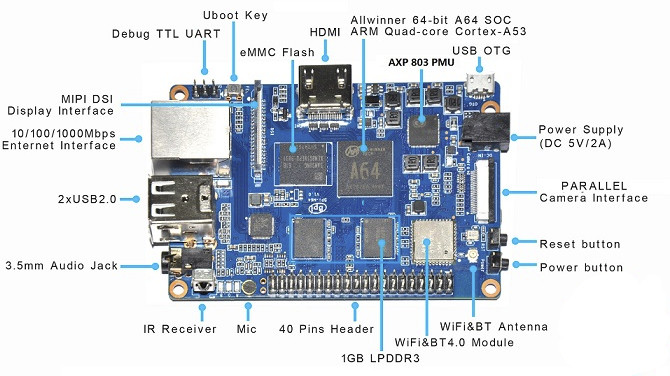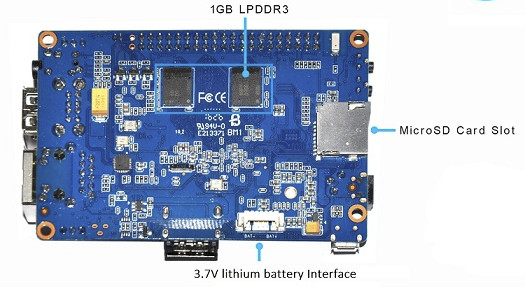Sinovoip has gone on the Allwinner A64 and 64-bit ARM bandwagon, announcing a Pine A64+ competitor, with Banana Pi BPI-M64 (or just Banana Pi M64) with 2GB RAM, 8GB eMMC flash, Gigabit Ethernet, and more.
 Banana Pi BPI-M64 board specifications:
Banana Pi BPI-M64 board specifications:
- SoC – Allwinner A64 quad core ARM Cortex A53 processor @ 1.2 GHz with Mali-400MP2 GPU
- System Memory – 2GB DDR3
- Storage – 8GB eMMC flash (16, 32 and 64GB options), micro SD slot up to 256 GB
- Video Output / Display interface – HDMI 1.4 up to 4K resolution @ 30 Hz, MIPI DSI interface
- Audio – HDMI, 3.5 mm headphone jack, built-in microphone
- Connectivity – Gigabit Ethernet + 802.11 b/g/n WiFi & Bluetooth 4.0 (AP6212)
- USB – 2x USB 2.0 host ports, 1x micro USB OTG port
- Camera – MIPI CSI interface (which I guess you support parallel cameras via some kind of bridge)
- Security – Hardware security enables ARM TrustZone, Digital Rights Management (DRM), information encryption/decryption, secure boot, secure JTAG and secure efuse
- Expansion – 40-pin Raspberry Pi 2 somewhat-compatible header
- Debugging – 3-pin UART header
- Misc – IR receiver; U-boot, reset and power buttons;
- Power – 5V via power barrel; 3.7V Lithium battery header; AXP803 PMIC
- Dimensions – N/A
 There’s some technical information on the Wiki, but currently limited to hardware (PDF schematics are coming soon), and Linux and Android software documentation links only being placeholders. So far, OS images have not been uploaded to the download page either.
There’s some technical information on the Wiki, but currently limited to hardware (PDF schematics are coming soon), and Linux and Android software documentation links only being placeholders. So far, OS images have not been uploaded to the download page either.
BPI-M64 is still work in progress, and I don’t know when it will be availability, but the company told me it would cost around $35. [Update: The board is now for sale on Aliexpress for about $50 shipped]
Thanks to tkaiser for the tip.

Jean-Luc started CNX Software in 2010 as a part-time endeavor, before quitting his job as a software engineering manager, and starting to write daily news, and reviews full time later in 2011.
Support CNX Software! Donate via cryptocurrencies, become a Patron on Patreon, or purchase goods on Amazon or Aliexpress




